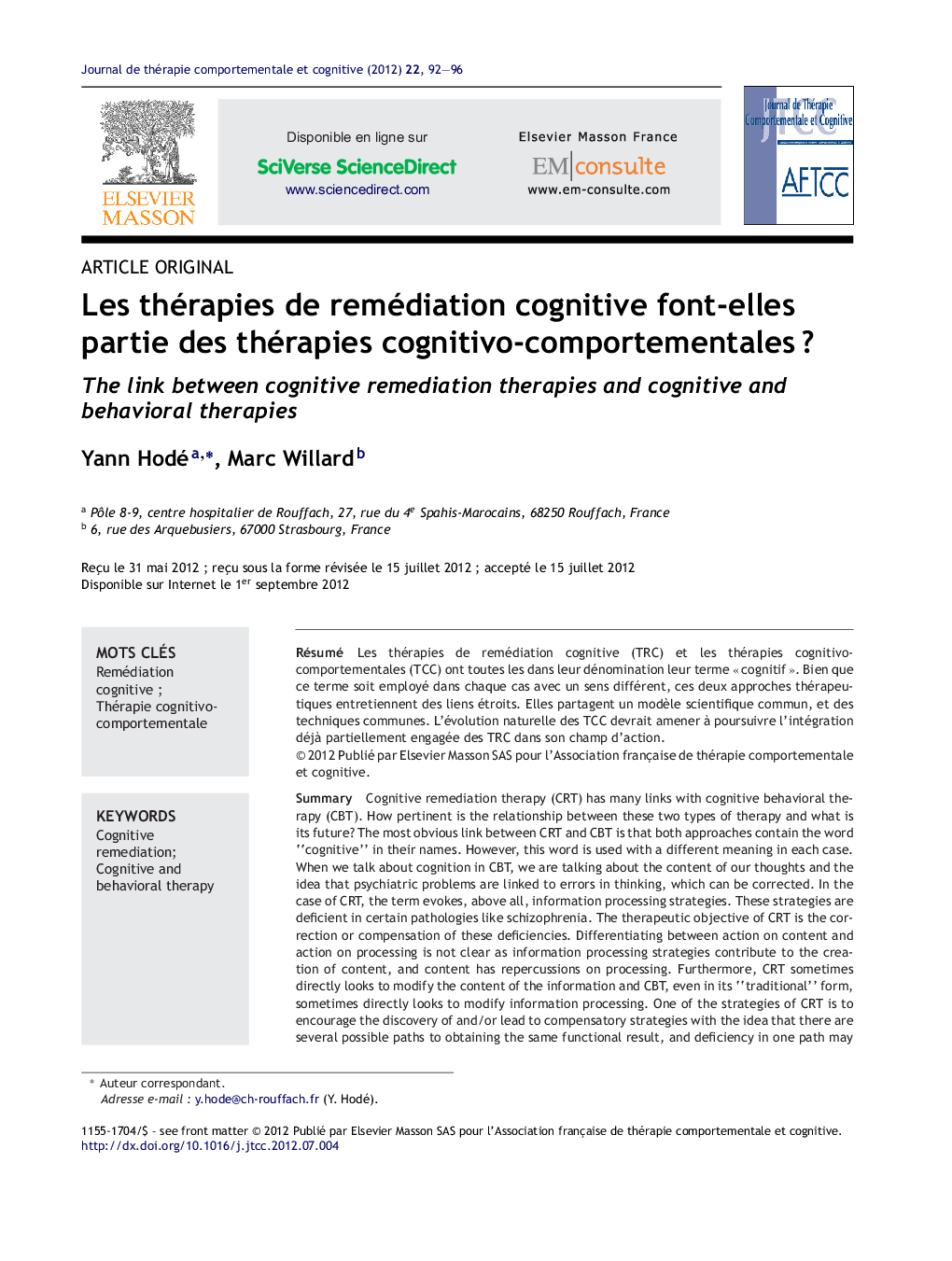| کد مقاله | کد نشریه | سال انتشار | مقاله انگلیسی | نسخه تمام متن |
|---|---|---|---|---|
| 934664 | 923685 | 2012 | 5 صفحه PDF | دانلود رایگان |
عنوان انگلیسی مقاله ISI
Les thérapies de remédiation cognitive font-elles partie des thérapies cognitivo-comportementales ?
دانلود مقاله + سفارش ترجمه
دانلود مقاله ISI انگلیسی
رایگان برای ایرانیان
کلمات کلیدی
موضوعات مرتبط
علوم پزشکی و سلامت
پزشکی و دندانپزشکی
روانپزشکی و بهداشت روانی
پیش نمایش صفحه اول مقاله

چکیده انگلیسی
Cognitive remediation therapy (CRT) has many links with cognitive behavioral therapy (CBT). How pertinent is the relationship between these two types of therapy and what is its future? The most obvious link between CRT and CBT is that both approaches contain the word “cognitive” in their names. However, this word is used with a different meaning in each case. When we talk about cognition in CBT, we are talking about the content of our thoughts and the idea that psychiatric problems are linked to errors in thinking, which can be corrected. In the case of CRT, the term evokes, above all, information processing strategies. These strategies are deficient in certain pathologies like schizophrenia. The therapeutic objective of CRT is the correction or compensation of these deficiencies. Differentiating between action on content and action on processing is not clear as information processing strategies contribute to the creation of content, and content has repercussions on processing. Furthermore, CRT sometimes directly looks to modify the content of the information and CBT, even in its “traditional” form, sometimes directly looks to modify information processing. One of the strategies of CRT is to encourage the discovery of and/or lead to compensatory strategies with the idea that there are several possible paths to obtaining the same functional result, and deficiency in one path may be compensated by overdevelopment of another path. Discovering compensatory mechanisms can be considered as action on the conscious representation a person has of their resources and problems and, in some way, is the alteration of the subject's internal speech in relation to their problems. This change in thought content is similar to CBT strategy. The compensation strategy may also seek to change the environment, allowing the patient to use other resources. Proper use of resources and the search for new resources results in the modification of thought content, for example, with the problem-solving technique. The major role given to learning theory in CBT shows the attention therapists give to processes (learning is a process) and not just to content. The work of deconditioning the systematic production of negative thoughts or strong emotional reactions consists in altering these processes. CBT and CRT have approaches sharing strong similarities. Furthermore, the wish to restrict the field of CBT to a purely cognitive and comportmental approach seems highly questionable. CBT is set up in stages, by aggregation of communities, techniques, innovations and concepts. The integration of these new concepts does not occur smoothly, causing multiple resistances. Faced with such resistances, it is important to realize that integration of techniques aimed at acting on cognitive processes is already an old fact in CBT. The CRT approach adheres to the scientific model and has largely integrated CBT tools, so it is naturally destined to be part of CBT. The question of therapist training then arises. The richer and more complex the techniques, the longer it will take to master them. This probably means that after a common core curriculum integrating theoretical comportmental and cognitive behavior, an introduction to the contributions of neuroscience and development of the scientific approach, different levels of specialization and expertise must be developed to enable the emergence of a modern, scientific psychotherapy.
ناشر
Database: Elsevier - ScienceDirect (ساینس دایرکت)
Journal: Journal de Thérapie Comportementale et Cognitive - Volume 22, Issue 3, September 2012, Pages 92-96
Journal: Journal de Thérapie Comportementale et Cognitive - Volume 22, Issue 3, September 2012, Pages 92-96
نویسندگان
Yann Hodé, Marc Willard,